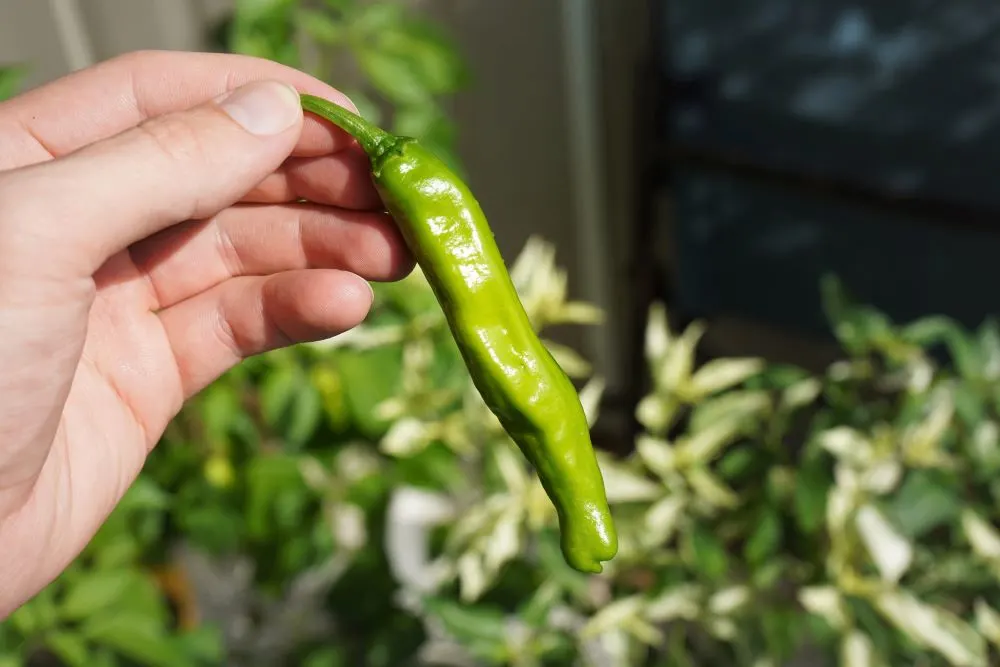Shishito peppers are becoming very popular in the US, but have been a staple in East Asia for centuries. Commonly thought of as a Japanese pepper, the shishito is incredibly versatile in cooking and preserving.
From pickling to frying to dehydrating for flakes, the shishito pepper is a great pepper to grow in your home garden. The relatively small plants are extremely productive and easy to grow from seed.
In this article, we’ll go through everything we know about shishito peppers. We will discuss their origin, size and shape, texture, flavor, uses and more. Let’s get started!

Shishito Pepper Facts
- Diameter: 0.5-0.75″
- Length: 3-4″
- Scoville (heat): 0-200 SHUs
- Color: Pale green to red
- Species: Capsicum annuum
- Seeds: Botanical Interests or RareSeeds
The long, slender peppers are full of folds and creases, giving them a vague resemblance to a groundcherry’s husk. For this reason, the shishito is referred to as the kkwarigochu (“groundcherry”) pepper in Korea.
Shishito Pepper Origins
Peppers were introduced to East Asia by Portuguese explorers in the 1500s. From there, peppers became widely cultivated in Japan, with desirable traits being selectively bred over planting generations.
Today, shishitos are widely grown in Japan, as well as in Europe and the United States. Like many pepper varieties, the seeds are widely available, making it easy to cultivate anywhere in the world.

Growing Shishito Peppers
Shishitos make a great starter pepper variety to grow at home. The plants are on the small side, and produce huge yields with very little effort! They are especially great for container gardening, or growing in a raised bed.
Learn how to grow shishitos with our pepper growing guide here.

Shishito Plant Characteristics
Shishito peppers are within the Capsicum annuum species, and they share some characteristics with other varieties within the species. The unique traits are that they are smaller than average (12-18″ tall), and have smaller leaves with dense foliage.
The plants are also highly productive relative to their size, typically producing several dozen peppers per plant. Shishito plants are also very early to produce fruits, making them a great option if you are planting late in the season or do not have a long growing season to begin with.
Flowers are pure white and produce heavy pollen, leading to consistently strong fruit sets. C. annuum plants can handle some drought, but like all peppers, they are not frost tolerant.
Shishito Pepper Characteristics
Shishito peppers are lightweight thanks to a very thin skin and walls. The 3-4″ long fruits are crunchy when picked green, but will ripen to a deep red color when fully mature. The peppers tend to lose crispness when fully ripe, so they are typically picked when still green for a firm texture.
The texture makes shishitos a great pepper for blistering over an open flame, or frying at high temperatures. Throw in a pinch of salt and you’ve got a great finger snack straight from the garden!
How Big To Shishito Pepper Plants Get?
If you plan to grow your own shishito peppers, you may wonder how big the plants will grow. On average, shishito pepper plants grow 12-18″ tall and wide. This is much smaller than your average plant, but the yield is still very high!
Shishito pepper plants are on the small side when compared to other popular varieties. For example, jalapeño pepper plants can grow between 3-4 feet tall. When pruned for trellising, bell peppers can grow over 10 feet tall!
Learn more about how tall peppers can grow here.
Shishito Peppers Scoville Scale
Shishito peppers are not considered to be spicy, though they can occasionally have a mild heat. They are much less spicy than a jalapeno, and most of the time, the peppers we grew were not spicy at all.
In short, shishito peppers are very mild, ranging from 0-200 Scoville heat units. They are speculated to have been bred from the padrón pepper, a Spanish variety that can produce both non-pungent and pungent peppers on each plant.

Shishito Pepper Flavor
Shishito peppers have a bright, fresh, vegetal flavor. They are slightly reminiscent of other sweet peppers, like bell peppers, but with a much different texture and shape to them. They are among the best tasting peppers out there, especially when pan fried with salt and oil.
Since they are so low in heat (usually none at all), I enjoyed biting into them fresh, right in the garden! However, they also have many culinary uses, some traditional, and many emerging recently.
Shishito Pepper Uses
Shishitos are commonly used as a salad topping, pan-fried with salt and spices, or pickled. The thin walls allow them to blister quickly over an open flame or a high-heat oiled pan.
Shishito pepper uses:
- Salad topper
- Pickled in a quick-pickle brine
- Blistered over hot grill
- Pan-fried with salt and spices
- Sandwich topper
- Dried and ground for pepper powder
These peppers are extremely versatile, and can make a great alternative to cayenne pepper powder if you do not like spicy food. Learn how to dehydrate peppers for powder here.
Shishito peppers are a joy to grow at home, and we love to have a plant going every year. The low to no-heat spice makes them very approachable to all gardeners, and the plants practically need no help at all!
Read Next:


Roberta
Thursday 15th of September 2022
I tried a young one and it didn’t have any heat, but as it got bigger it definitely was spicy.
Kevin C
Tuesday 21st of September 2021
I bought a pack of seeds from our Korean Grocer that look like kkwarigochu (Shishito) but these peppers have a good bit of heat to them. On the packet they are a variety called Han Lim. I was wondering if you have ever encountered them or had more information on these peppers?